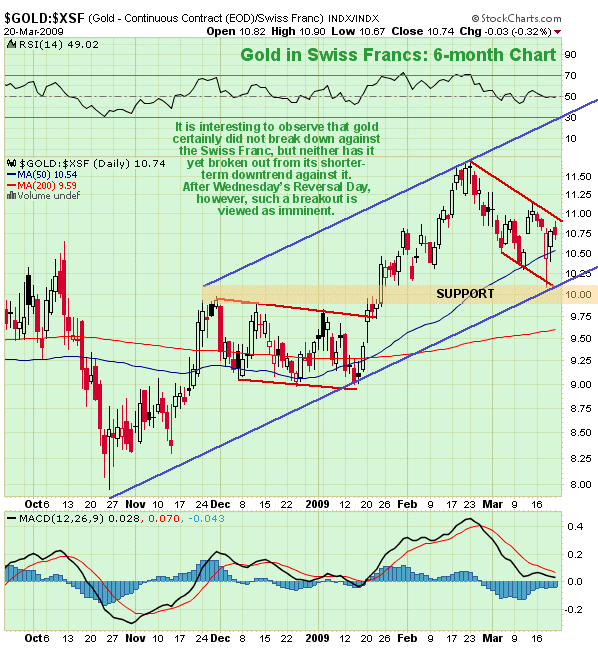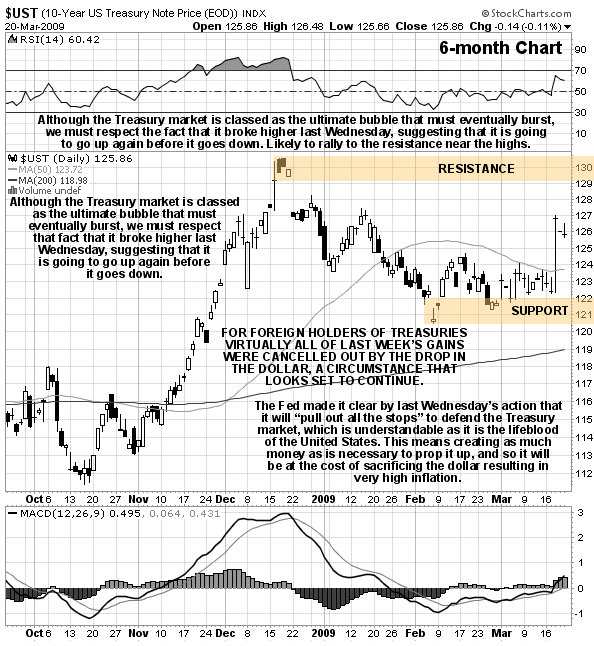Fed illusion as Rising U.S. Bond Prices Cancelled Out by Plunging Dollar
Interest-Rates / US Bonds Mar 22, 2009 - 12:07 PM GMTBy: Clive_Maund

 Last week a very dangerous precedent was set when the Fed announced that it is going to start overtly intervening to backstop the ailing Treasury market. The market's verdict on this announcement was immediate and unequivocal. While Treasuries rallied sharply as one might expect, the dollar cratered and gold staged a dramatic turnaround to close sharply higher. The reason that this precedent is so dangerous is that once they start monetising this debt, which means creating money to buy that portion of newly created Treasury debt that cannot be sold off, there will be no end to it - they will eventually find themselves buying more and more of it, as foreign buyers continue to withdraw, deterred by a combination of pitifully low yields and any prospective capital gain being wiped out by the continued decline in the dollar that must transpire as a result of diluting the currency by creating money to absorb unsold Treasury paper.
Last week a very dangerous precedent was set when the Fed announced that it is going to start overtly intervening to backstop the ailing Treasury market. The market's verdict on this announcement was immediate and unequivocal. While Treasuries rallied sharply as one might expect, the dollar cratered and gold staged a dramatic turnaround to close sharply higher. The reason that this precedent is so dangerous is that once they start monetising this debt, which means creating money to buy that portion of newly created Treasury debt that cannot be sold off, there will be no end to it - they will eventually find themselves buying more and more of it, as foreign buyers continue to withdraw, deterred by a combination of pitifully low yields and any prospective capital gain being wiped out by the continued decline in the dollar that must transpire as a result of diluting the currency by creating money to absorb unsold Treasury paper.
When you perform work or provide services for a debt-wracked spendthrift you should have a pretty good idea that their IOU's are never likely to be honored, and are thus not likely to be worth the paper they are written on. The Chinese, who have been supplying the United States with vast quantities of consumer goods for years in exchange for Treasury Bills and Bonds, which are a form of IOU, and various other dubious "investments", have been slowly waking up in recent months to the fact that they "have been had". They have been breaking out in a cold sweat as they realize that they have in effect been conned out of trillions. Thus they have been attempting to scale back their purchases of US Treasuries in an effort to stop throwing good money after bad, and have been accumulating more gold. This has increasingly threatened to pull the rug from under the Treasury market. The Chinese (and others) are in a "catch 22" situation with regard to their vast holdings of US debt, as if they make any serious attempt to divest themselves of it in significant quantities they will collapse the market. They are therefore to a large extent stuck with it - all they can do is drastically scale back purchases and try to offload as much of it as they can clandestinely. However, the reduced demand resulting from their change of stance has nevertheless been threatening to bring down the Treasury market. The Chinese are going to lose big time, and last week the Fed decided the manner of their losing.
They won't lose as a result of falling Treasury prices - at least not for now - they are going to lose due to a severe devaluation of the dollar. The big danger to the Treasury market and to the United States by extension is that the Chinese and others put two and two together and, realizing they are about to be fleeced by a falling dollar, decide to cash in for what they can get ahead of the dollar collapse. This would cause the Treasury market to collapse rapidly, and the Fed, having last week "thrown down the gauntlet" would find itself having to buy up Treasuries not just to the tune of a few hundred billions of dollars but by the trillions, all the extra money created for this purpose rapidly feeding through into the economy as a hyperinflationary meltdown. If they don't buy the unsold Treasuries their price will plummet causing interest rates to spike to levels that would almost immediately bring the hugely indebted US economy to a dead stop. Since we know how their minds work - they take the path of least resistance - we know that they are going to create as much money as it takes to prop up the Treasury market, happy to push the ultimate cost of this on to the man in the street in the form of massive inflation or even hyperinflation. This is the message that they telegraphed to the markets - and to the world at large - last week.
This was great news for China, which is desperate to cash in its war chest of accumulated US debt to use for more constructive purposes, such as supporting its flagging economy and buying commodities and hard assets for the future. So the Chinese response to the Fed's newly proclaimed stance will be "Thanks very much - sold to you!" and they will in effect call the Fed's bluff by selling and selling and selling, knowing that they can't back down, can't let the Treasury market collapse because of their dread of an interest rate spike, and thus must manufacture trillions and trillions of dollars to buy Treasuries. Hence the bill for all the excesses of many years of debt financed overconsumption will finally land on the doormat of the US consumer in the form of a plunging currency and hyperinflation, although China will still pay a heavy price because of the collapse of the dollar. Those who think that the $300 billion Treasury purchase is a one-off event are presumably the same people who thought that the big $780 billion bail out package that caused such a furore last year was the same.
Countless other countries and trading blocs around the world, also faced with massive debt and liquidity problems, are resorting to the printing press as the fix, and so diluting and debasing their currencies, and have the added incentive that a falling currency makes their exports more competitive. So we can expect them to follow the US example, if not on such a grand scale. Thus investors who wish to preserve their capital will turn increasingly to commodities and hard assets, and in particular to gold, which can be expected to continue to rise against most currencies.

We will now examine last week's action on the charts. On the 6-month gold chart we can see that a dramatic Reversal Day occurred on Wednesday, with the price dropping steeply in the early trade so that it appeared to be breaking down from a Head-and-Shoulders top area. The news from the Fed caused the dollar to plunge and gold staged a rapid turnaround after digging deeply into the support level shown to climb back into its uptrend channel so that it finished well up on the day, thus aborting the potential Head-and-Shoulders top. This was very bullish action that marked a reversal. In addition we can see that Thursday's additiional gains resulted in the MACD indicator shown at the bottom of the chart rising up through its moving average not far enough the neutral line, a further sign that a new uptrend has begun. The magnitude of the reversal on Wednesday has measuring implications that point to the new intermediate uptrend taking the price to the upper return line of the channel shown, meaning to the $1080 - $110 area, although we should expect gold to pause for a while to consolidate before it breaks above the February high.

Given that last week's big jump by gold was largely in response to the dollar cratering it is clearly worthwhile to see how it performed against other currencies at the same time. The chart for gold against the Swiss Franc is interesting as it reveals that although gold put in a probable Reversal Day against this currency too on Wednesday, it still closed down on the week, and it has not as yet broken out from the intermediate downtrend in force from mid-late February, in contrast to the dollar chart where it has staged a clear breakout. However, the action this past week against the Swiss is certainly regarded as bullish for we can see that early on Wednesday gold dropped to successfully test the strong support shown which was augmented by the support line of the important uptrend channel shown and it closed well up and back above its rising 50-day moving average, so a breakout from the intermediate downtrend is thought to be imminent. The RSI and MACD indicators are both close to neutrality, showing that there is plenty of upside potential from here.

The 1-year dollar index chart reveals that the dollar is breaking down from a large Double Top area. The magnitude of the huge drop on Wednesday, which was the largest one day drop for over twenty years, projects a savage decline, with the first target being the support level shown in the 77 - 78.50 area. It had become extremely oversold by Friday morning, as shown by the RSI indicator and MACD histogram (blue bars), hence yesterday's bounce. However, it is expected to have little respite before the decline begins again in earnest, and unlike the drop in December, the 200-day moving average is expected to provide scant relief. This chart shows that the dollar spike, driven by massive liquidation and repatriation of funds, and by a flight into Treasuries, is over.

We will finish by looking at the chart for the 10-year US Treasury Note, one of the beneficiaries of the Fed's new largesse. Not surprisingly it staged a huge breakout on the news that the Fed is going to use its money factory to prop the market up, but what is even more remarkable is that the gain was almost completely cancelled out by the huge drop in the dollar on the same day. Nevertheless this move in itself was bullish for the short to medium-term, so we may see Treasuries advance back towards their highs which anyone holding should utilize as a last opportunity to get out at good prices, for the longer-term outlook is grim.
By Clive Maund
CliveMaund.com
For billing & subscription questions: subscriptions@clivemaund.com
© 2009 Clive Maund - The above represents the opinion and analysis of Mr. Maund, based on data available to him, at the time of writing. Mr. Maunds opinions are his own, and are not a recommendation or an offer to buy or sell securities. No responsibility can be accepted for losses that may result as a consequence of trading on the basis of this analysis.
Mr. Maund is an independent analyst who receives no compensation of any kind from any groups, individuals or corporations mentioned in his reports. As trading and investing in any financial markets may involve serious risk of loss, Mr. Maund recommends that you consult with a qualified investment advisor, one licensed by appropriate regulatory agencies in your legal jurisdiction and do your own due diligence and research when making any kind of a transaction with financial ramifications.
Clive Maund Archive |
© 2005-2022 http://www.MarketOracle.co.uk - The Market Oracle is a FREE Daily Financial Markets Analysis & Forecasting online publication.
Comments
|
Talitha
22 Mar 09, 20:51 |
Tiny Tim and Bernanke Team Up To Ruin The World
Tiny Tim Geithner and Helicopter Ben Bernanke are going to ruin this country. They both need to GO! |


